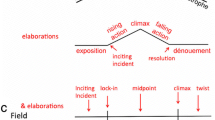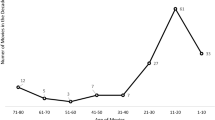Abstract
For psychiatric educators interested in using film to teach professional and lay audiences about schizophrenia, the 2001 release of A Beautiful Mind has made the process much easier. The movie shows a range of symptoms and complications, and it gives viewers—especially patients and families—hope for recovery. However, many other commercial films depict various aspects of the illness, and the choice of which one to use is determined by the audience, the pedagogical focus, and the time available. Clean, Shaven (1995), for instance, may be more challenging for professional audiences. Psychiatric educators should familiarize themselves with the variety of film options when teaching about schizophrenia.
Similar content being viewed by others
Reference
McNeilly DP, Wengel SP: The “ER” seminar: teaching psychotherapeutic techniques to medical students. Acad Psychiatry 2001; 25: 193–200
Misch DA: Psychosocial formulation training using commercial films. Acad Psychiatry 2000; 24: 99–104
Sondheimer A: The life stories of children and adolescents: using commercial films as teaching aids. Acad Psychiatry 2000; 24: 214–224
Wedding D, Boyd MA: Movies and Mental Illness: Using Films to Understand Psychopathology. New York, McGraw-Hill College, 1999
Hyler SE, Moore J: Teaching psychiatry? Let Hollywood help! Acad Psychiatry 1996, 20: 212–219
Hyler SE, Gabbard GO, Schneider I: Homicidal maniacs and narcissistic parasites: stigmatization of mentally ill persons in the movies. Hosp Community Psychiatry 1991; 42: 1044–1048
Green B: Psychiatry and the Cinema. http://www.priory.com/psych/psycinema.htm, 2002
Internet Movie Database: “A Beautiful Mind.” http://us.imdb.com/Title?0268978, 2002
NAMI Offers Perspective on “A Beautiful Mind”: Living With Schizophrenia. http://www.nami.org/pressroom/20011212.html Dec 12, 2001
David A: Reviews: “A Beautiful Mind.” BMJ 2002; 324: 491
Nassar S: A Beautiful Mind: The Life of Mathematical Genius and Nobel Laureate John Nash. New York, Touchstone Books, 1998
Santarelli M, Alacron WJ, Norcross JC: See you at the movies: expert ratings on popular films for six psychological disorders. Poster presented at the 71st annual meeting of the Eastern Psychological Association, Baltimore, March 2000
Berardinelli J: “Clean, Shaven”: a film review. http://movie-reviews.colossus.net/movies/c/clean_shaven.html 1995
Internet Movie Database: “Clean, Shaven.” http://us.imdb.com/Title?0106579 2002
Guthmann E: “Clean” tells an untidy tale of madness: grisly drama is low-budget but effective. San Francisco Chronicle, Sept 20, 1995
Ebert R: “Clean, Shaven.” Chicago Sun-Times, March 31, 1995
Gabbard GO, Gabbard K: Psychiatry and the Cinema, 2nd ed. Washington, DC, American Psychiatric Press, 1999
Author information
Authors and Affiliations
Corresponding author
Additional information
The author thanks Rohan Ganguli and Harold Pincus for their assistance in the development of this paper.
Rights and permissions
About this article
Cite this article
Rosenstock, J. Beyond A Beautiful Mind: Film Choices for Teaching Schizophrenia. Acad Psychiatry 27, 117–122 (2003). https://doi.org/10.1176/appi.ap.27.2.117
Published:
Issue Date:
DOI: https://doi.org/10.1176/appi.ap.27.2.117




